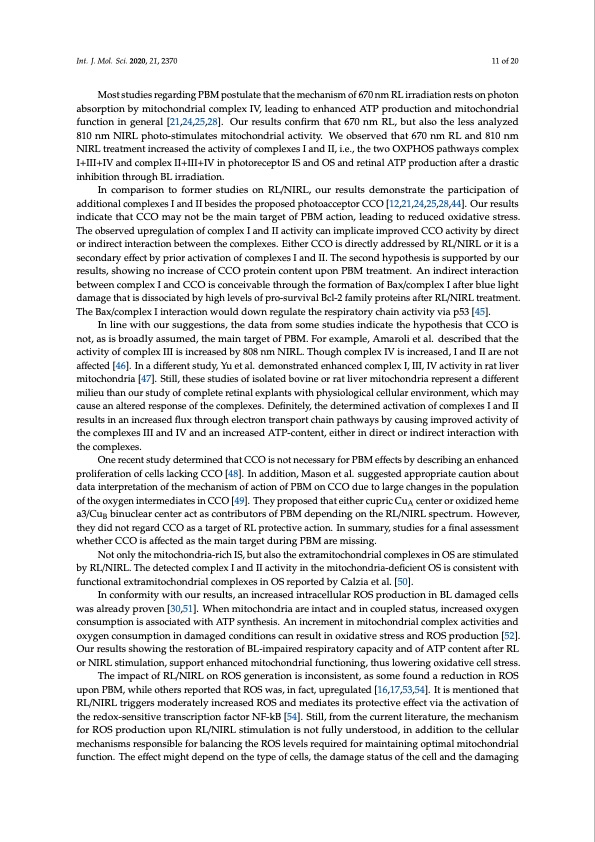
PDF Publication Title:
Text from PDF Page: 011
Int. J. Mol. Sci. 2020, 21, 2370 11 of 20 Most studies regarding PBM postulate that the mechanism of 670 nm RL irradiation rests on photon absorption by mitochondrial complex IV, leading to enhanced ATP production and mitochondrial function in general [21,24,25,28]. Our results confirm that 670 nm RL, but also the less analyzed 810 nm NIRL photo-stimulates mitochondrial activity. We observed that 670 nm RL and 810 nm NIRL treatment increased the activity of complexes I and II, i.e., the two OXPHOS pathways complex I+III+IV and complex II+III+IV in photoreceptor IS and OS and retinal ATP production after a drastic inhibition through BL irradiation. In comparison to former studies on RL/NIRL, our results demonstrate the participation of additional complexes I and II besides the proposed photoacceptor CCO [12,21,24,25,28,44]. Our results indicate that CCO may not be the main target of PBM action, leading to reduced oxidative stress. The observed upregulation of complex I and II activity can implicate improved CCO activity by direct or indirect interaction between the complexes. Either CCO is directly addressed by RL/NIRL or it is a secondary effect by prior activation of complexes I and II. The second hypothesis is supported by our results, showing no increase of CCO protein content upon PBM treatment. An indirect interaction between complex I and CCO is conceivable through the formation of Bax/complex I after blue light damage that is dissociated by high levels of pro-survival Bcl-2 family proteins after RL/NIRL treatment. The Bax/complex I interaction would down regulate the respiratory chain activity via p53 [45]. In line with our suggestions, the data from some studies indicate the hypothesis that CCO is not, as is broadly assumed, the main target of PBM. For example, Amaroli et al. described that the activity of complex III is increased by 808 nm NIRL. Though complex IV is increased, I and II are not affected [46]. In a different study, Yu et al. demonstrated enhanced complex I, III, IV activity in rat liver mitochondria [47]. Still, these studies of isolated bovine or rat liver mitochondria represent a different milieu than our study of complete retinal explants with physiological cellular environment, which may cause an altered response of the complexes. Definitely, the determined activation of complexes I and II results in an increased flux through electron transport chain pathways by causing improved activity of the complexes III and IV and an increased ATP-content, either in direct or indirect interaction with the complexes. One recent study determined that CCO is not necessary for PBM effects by describing an enhanced proliferation of cells lacking CCO [48]. In addition, Mason et al. suggested appropriate caution about data interpretation of the mechanism of action of PBM on CCO due to large changes in the population of the oxygen intermediates in CCO [49]. They proposed that either cupric CuA center or oxidized heme a3/CuB binuclear center act as contributors of PBM depending on the RL/NIRL spectrum. However, they did not regard CCO as a target of RL protective action. In summary, studies for a final assessment whether CCO is affected as the main target during PBM are missing. Not only the mitochondria-rich IS, but also the extramitochondrial complexes in OS are stimulated by RL/NIRL. The detected complex I and II activity in the mitochondria-deficient OS is consistent with functional extramitochondrial complexes in OS reported by Calzia et al. [50]. In conformity with our results, an increased intracellular ROS production in BL damaged cells was already proven [30,51]. When mitochondria are intact and in coupled status, increased oxygen consumption is associated with ATP synthesis. An increment in mitochondrial complex activities and oxygen consumption in damaged conditions can result in oxidative stress and ROS production [52]. Our results showing the restoration of BL-impaired respiratory capacity and of ATP content after RL or NIRL stimulation, support enhanced mitochondrial functioning, thus lowering oxidative cell stress. The impact of RL/NIRL on ROS generation is inconsistent, as some found a reduction in ROS upon PBM, while others reported that ROS was, in fact, upregulated [16,17,53,54]. It is mentioned that RL/NIRL triggers moderately increased ROS and mediates its protective effect via the activation of the redox-sensitive transcription factor NF-kB [54]. Still, from the current literature, the mechanism for ROS production upon RL/NIRL stimulation is not fully understood, in addition to the cellular mechanisms responsible for balancing the ROS levels required for maintaining optimal mitochondrial function. The effect might depend on the type of cells, the damage status of the cell and the damagingPDF Image | Photobiomodulation Mediates Neuroprotection against Retinal

PDF Search Title:
Photobiomodulation Mediates Neuroprotection against RetinalOriginal File Name Searched:
ijms-21-02370.pdfDIY PDF Search: Google It | Yahoo | Bing
Cruise Ship Reviews | Luxury Resort | Jet | Yacht | and Travel Tech More Info
Cruising Review Topics and Articles More Info
Software based on Filemaker for the travel industry More Info
The Burgenstock Resort: Reviews on CruisingReview website... More Info
Resort Reviews: World Class resorts... More Info
The Riffelalp Resort: Reviews on CruisingReview website... More Info
| CONTACT TEL: 608-238-6001 Email: greg@cruisingreview.com | RSS | AMP |